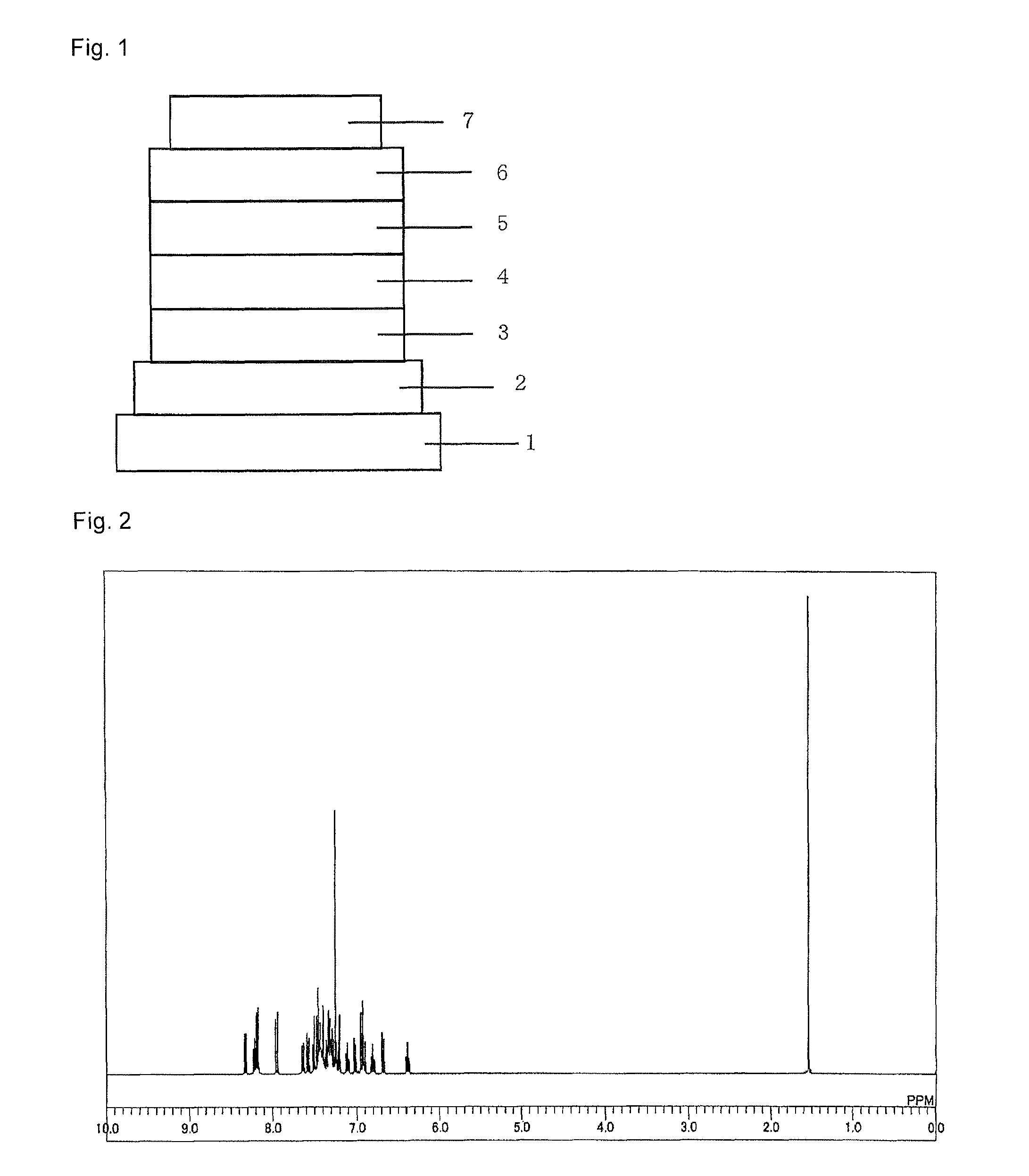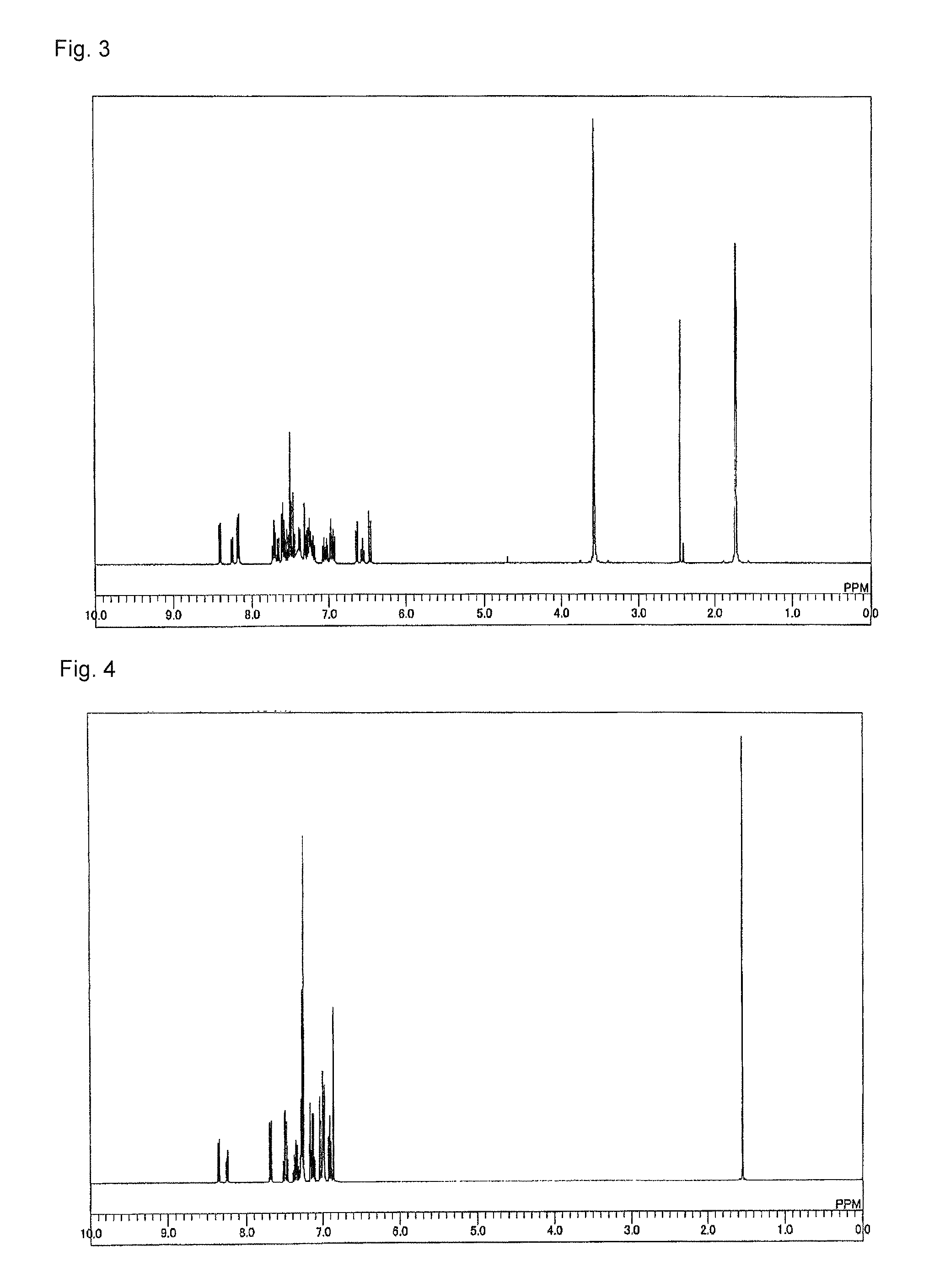Organic electroluminescent device
a technology of electroluminescent devices and electroluminescent materials, which is applied in the direction of luminescent compositions, organic chemistry, chemistry apparatus and processes, etc., can solve the problems of insatisfactory practical use of mcp, inability to emit light at high efficiency, and excessive holes to flow out to the side of the electron-transporting layer, etc., to achieve high reactivity, deteriorate durability, and high electron density
- Summary
- Abstract
- Description
- Claims
- Application Information
AI Technical Summary
Benefits of technology
Problems solved by technology
Method used
Image
Examples
synthetic example 1
Synthesis of Compound 1
[0123]
[0124]Under a nitrogen atmosphere, 7.0 g (0.0313 mol) of palladium acetate, 88 g (0.0626 mol) of a 20 wt % toluene solution of tricyclohexylphosphine, and 150 mL of 1-methylpyrrolidone (NMP) were stirred at 60° C. for 1 hour. To the resulting yellow solution were added 69.6 g (0.627 mol) of 1-fluoroaniline, 100 g (0.522 mol) of 1-bromochlorobenzene, 330 g (1.56 mol) of tripotassium phosphate, and 1,500 mL of NMP with stirring at room temperature. Thereafter, the mixture was stirred at 130° C. overnight. The reaction solution was cooled to room temperature, then the precipitated crystal was collected by filtration, and the solvent was distilled off under reduced pressure. The residue thus obtained was purified by silica gel column chromatography to give 19.53 g (0.105 mol, 20.2% yield) of Intermediate A as a white solid.
[0125]Under a nitrogen atmosphere, 40.0 g (0.117 mol) of 2,8-dibromodibenzothiophene, 24.0 g (0.143 mol) of carbazole, 89.1 g (0.468 mol)...
synthetic example 2
Synthesis of Compound 2
[0128]
[0129]Under a nitrogen atmosphere, 25.0 g (0.0623 mol) of 3,6-dibromo-9-phenylcarbazole, 10.4 g (0.0623 mol) of carbazole, 2.38 g (0.0125 mol) of copper iodide, 52.9 g (0.249 mol) of tripotassium phosphate, 14.2 g (0.124 mol) of trans-1,2-cyclohexanediamine, and 1,000 mL of 1,4-dioxane were heated at 90° C. with stirring for 1 hour. The reaction solution was cooled to room temperature, then the precipitated crystal was collected by filtration, and the solvent was distilled off under reduced pressure. The residue thus obtained was purified by silica gel column chromatography to give 12.9 g (26.4 mmol, 42.4% yield) of Intermediate D as a white solid.
[0130]Under a nitrogen atmosphere, 6.4 g (0.0346 mol) of Intermediate A, 13.0 g (0.0266 mol) of Intermediate D, 20.2 g (0.106 mol) of copper iodide, 22.5 g (0.106 mol) of tripotassium phosphate, 12.7 mL (0.106 mol) of trans-1,2-cyclohexanediamine, and 115 mL of 1,4-dioxane were heated at 110° C. with stirring o...
synthetic example 3
Synthesis of Compound 18
[0132]
[0133]Under a nitrogen atmosphere, 69.2 g (0.219 mol) of 1,3,5-tribromobenzene, 54.5 g (0.447 mol) of phenylboronic acid, 12.0 g (0.0104 mol) of tetrakis(triphenylphosphine)palladium(0), a solution of 121 g of sodium carbonate in water (450 mL), 800 mL of toluene, and 400 mL of ethanol were stirred at 90° C. for 2 hours. The reaction solution was cooled to room temperature and then distilled water (500 mL) and toluene (500 mL) were added with stirring. The organic layer was washed with distilled water (3×500 mL). The organic layer was dried over anhydrous magnesium sulfate, the magnesium sulfate was separated by filtration, and the solvent was distilled off under reduced pressure. The residue thus obtained was purified by silica gel column chromatography to give 44.7 g (0.144 mol, 65.7% yield) of Intermediate F as a white solid.
[0134]Under a nitrogen atmosphere, 4.00 g (0.0216 mol) of Intermediate A, 10.0 g (0.0323 mol) of Intermediate F, 16.5 g (0.0864...
PUM
| Property | Measurement | Unit |
|---|---|---|
| peak wavelength | aaaaa | aaaaa |
| work function | aaaaa | aaaaa |
| transmittance | aaaaa | aaaaa |
Abstract
Description
Claims
Application Information
 Login to View More
Login to View More - R&D
- Intellectual Property
- Life Sciences
- Materials
- Tech Scout
- Unparalleled Data Quality
- Higher Quality Content
- 60% Fewer Hallucinations
Browse by: Latest US Patents, China's latest patents, Technical Efficacy Thesaurus, Application Domain, Technology Topic, Popular Technical Reports.
© 2025 PatSnap. All rights reserved.Legal|Privacy policy|Modern Slavery Act Transparency Statement|Sitemap|About US| Contact US: help@patsnap.com



